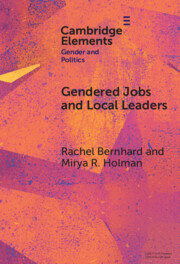56 results
Co-opting the state: mobilizing environmental justice claims in a regulatory agency
-
- Journal:
- Law & Society Review / Volume 59 / Issue 1 / March 2025
- Published online by Cambridge University Press:
- 28 March 2025, pp. 82-105
- Print publication:
- March 2025
-
- Article
-
- You have access
- Open access
- HTML
- Export citation

Gendered Jobs and Local Leaders
- Women, Work, and the Pipeline to Local Political Office
-
- Published online:
- 07 February 2025
- Print publication:
- 06 March 2025
-
- Element
-
- You have access
- Open access
- HTML
- Export citation
Hometown Advantage: Voter Preferences for Community Embeddedness in Local Contests
-
- Journal:
- Journal of Experimental Political Science , First View
- Published online by Cambridge University Press:
- 03 December 2024, pp. 1-15
-
- Article
-
- You have access
- Open access
- HTML
- Export citation
Measuring Mayoral Responsiveness to Latine Lesbians and Gay Men
-
- Journal:
- Journal of Race, Ethnicity and Politics / Volume 9 / Issue 3 / November 2024
- Published online by Cambridge University Press:
- 17 October 2024, pp. 539-570
-
- Article
-
- You have access
- Open access
- HTML
- Export citation
From Crowdfunding to Crowd Mobilization: The Impact of Digital Philanthropy on Grassroots Organizations and Local Politics in China
-
- Journal:
- The China Quarterly , First View
- Published online by Cambridge University Press:
- 16 November 2023, pp. 1-19
-
- Article
-
- You have access
- Open access
- HTML
- Export citation

Restrained Radicals
- Populist Radical Right Parties in Local Government
-
- Published online:
- 10 August 2023
- Print publication:
- 10 August 2023
4 - Do They Make a Difference? The Policy Impact of Populist Radical Right Parties in Local Power
-
- Book:
- Restrained Radicals
- Published online:
- 10 August 2023
- Print publication:
- 10 August 2023, pp 101-135
-
- Chapter
- Export citation
6 - Laboratories or Showcases? Explaining the Varied Forms of Local Government under Populist Radical Right Mayors
-
- Book:
- Restrained Radicals
- Published online:
- 10 August 2023
- Print publication:
- 10 August 2023, pp 171-207
-
- Chapter
- Export citation
5 - Mainstreaming
-
- Book:
- Restrained Radicals
- Published online:
- 10 August 2023
- Print publication:
- 10 August 2023, pp 136-170
-
- Chapter
- Export citation
2 - Going Local
-
- Book:
- Restrained Radicals
- Published online:
- 10 August 2023
- Print publication:
- 10 August 2023, pp 25-59
-
- Chapter
- Export citation
7 - Conclusion
-
- Book:
- Restrained Radicals
- Published online:
- 10 August 2023
- Print publication:
- 10 August 2023, pp 208-226
-
- Chapter
- Export citation
1 - Introduction
-
- Book:
- Restrained Radicals
- Published online:
- 10 August 2023
- Print publication:
- 10 August 2023, pp 1-24
-
- Chapter
- Export citation
3 - The Entry of Populist Radical Right Parties into Local Power
-
- Book:
- Restrained Radicals
- Published online:
- 10 August 2023
- Print publication:
- 10 August 2023, pp 60-100
-
- Chapter
- Export citation
The Strange Career of Federal Indian Policy: Rural Politics, Native Nations, and the Path Away from Assimilation
-
- Journal:
- Studies in American Political Development / Volume 37 / Issue 2 / October 2023
- Published online by Cambridge University Press:
- 06 June 2023, pp. 89-110
-
- Article
- Export citation
Changing faces of political women in Tokyo
-
- Journal:
- Japanese Journal of Political Science / Volume 24 / Issue 1 / March 2023
- Published online by Cambridge University Press:
- 04 January 2023, pp. 1-16
-
- Article
-
- You have access
- Open access
- HTML
- Export citation
3 - Shifting Dynamics of Race and Local Politics
- from Part I - Beginnings: Routes to the Present
-
- Book:
- The Unfinished Politics of Race
- Published online:
- 18 November 2022
- Print publication:
- 01 December 2022, pp 44-70
-
- Chapter
- Export citation
Conclusion
-
- Book:
- Sunni City
- Published online:
- 10 November 2022
- Print publication:
- 24 November 2022, pp 228-240
-
- Chapter
- Export citation
5 - The Future Movement
-
- Book:
- Sunni City
- Published online:
- 10 November 2022
- Print publication:
- 24 November 2022, pp 140-174
-
- Chapter
- Export citation
6 - Progress and Failure in Achieving Equal Representation
- from Part I - The Contested Idea of Political Representation
-
-
- Book:
- Contested Representation
- Published online:
- 03 November 2022
- Print publication:
- 17 November 2022, pp 82-100
-
- Chapter
- Export citation
6 - Solidarity in the City
-
-
- Book:
- Inscribing Solidarity
- Published online:
- 03 November 2022
- Print publication:
- 17 November 2022, pp 98-118
-
- Chapter
-
- You have access
- Open access
- HTML
- Export citation

